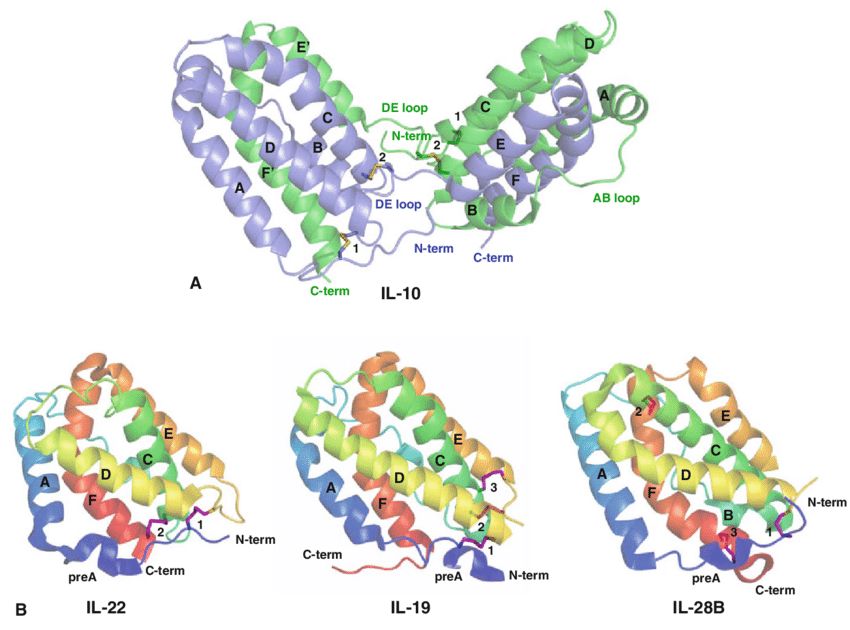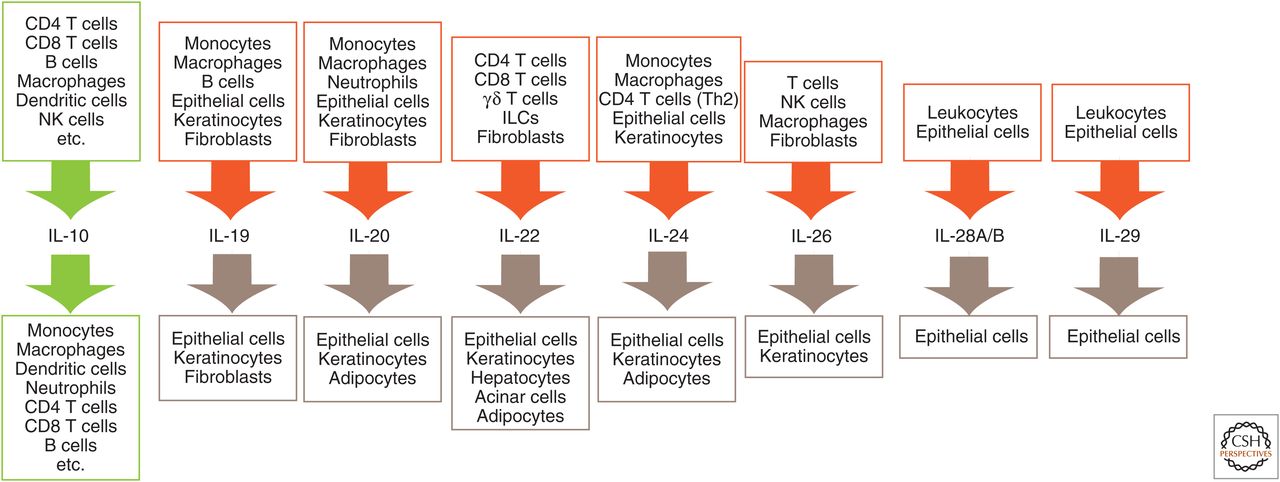IL-10 Family Ligands
Available Resources for IL-10 Family Ligands Research
At Creative BioMart, we take pride in offering a comprehensive range of products dedicated to the study of IL-10 family ligands. Our diverse selection includes recombinant proteins, magnetic beads coupled with proteins, and cell and tissue lysates. These high-quality products serve as indispensable tools for researchers, providing them with the necessary resources for their investigations. We understand that each research project has unique requirements, which is why we offer customizable services to ensure that you receive the most suitable product tailored to your specific needs.
In addition to our extensive product line, we provide a wealth of information and resources on IL-10 family ligands. Our resources cover a wide range of topics, including pathways, protein function, interacting proteins, related articles, and research areas. These valuable references are designed to deepen researchers' understanding of IL-10 family ligands and their significance in physiological processes. We believe that by offering both products and knowledge, we can effectively support researchers and make meaningful contributions to advancements in this field of study.
Our Featured Products
| Cat.# | Product name | Species | Source (Host) | Tag |
|---|---|---|---|---|
| IL29-381H | Recombinant Human IL29 protein, His-tagged | Human | HEK293 | His |
| IL28B-379H | Recombinant Human IL28B, His tagged | Human | Human Cell | His |
| IL28B-4370E | Recombinant Equine IL28B Protein | Equine | Yeast | N/A |
| IL20-14181H | Recombinant Human IL20, GST-tagged | Human | E.coli | GST |
| IL19-14165H | Recombinant Human IL19, His-tagged | Human | E.coli | His |
| IL22-14185H | Recombinant Human IL22, GST-tagged | Human | E.coli | GST |
| IL22-60Z | Recombinant Zebrafish IL22 Protein, His-tagged | Zebrafish | E.coli | His |
| IL24-14189H | Recombinant Human IL24, GST-tagged | Human | E.coli | GST |
| Il24-30R | Recombinant Rat Il24 protein, His-tagged | Rat | E.coli | His |
About IL-10 Family Ligands
The IL-10 family is a group of cytokines that share structural and functional similarities with interleukin-10 (IL-10). These cytokines play important roles in regulating immune responses and inflammation. Here's an introduction to some key members of the IL-10 family ligands:
- Interleukin-10 (IL-10) is the prototypical member of the IL-10 family and is primarily produced by immune cells, such as T cells, B cells, macrophages, and dendritic cells. It acts as an anti-inflammatory cytokine and plays a crucial role in dampening excessive immune responses and promoting immune tolerance. IL-10 inhibits the production of pro-inflammatory cytokines and chemokines, suppresses antigen presentation and T cell activation, and can directly inhibit the function of various immune cells.
- Interleukin-19 (IL-19) is a member of the IL-10 family that is mainly produced by immune cells, including monocytes, macrophages, and dendritic cells. It is involved in regulating immune responses and has been implicated in various inflammatory conditions. IL-19 can promote the production of pro-inflammatory mediators, such as IL-6 and TNF-α, and is known to modulate the function of immune cells, including T cells and dendritic cells.
- Interleukin-20 (IL-20) is another member of the IL-10 family that is produced by activated monocytes, macrophages, and keratinocytes. It has diverse functions and is involved in various processes, including skin inflammation, wound healing, and tissue repair. IL-20 can stimulate the production of pro-inflammatory cytokines and chemokines, promote angiogenesis, and influence the differentiation and function of epithelial cells.
- Interleukin-22 (IL-22) is an IL-10 family cytokine primarily produced by immune cells, such as T cells and innate lymphoid cells. It plays important roles in tissue homeostasis, barrier function, and protection against pathogens. IL-22 can stimulate the production of antimicrobial peptides, promote tissue repair and regeneration, and contribute to the defense against bacterial and fungal infections. It is particularly involved in maintaining the integrity of epithelial barriers, such as the skin and gut.
- Interleukin-24 (IL-24), also known as melanoma differentiation-associated gene 7 (MDA-7), is a member of the IL-10 family that is produced by various cell types, including immune cells and non-immune cells. It has diverse functions and has been implicated in cancer, inflammation, and immune regulation. IL-24 can have both pro-inflammatory and anti-inflammatory effects depending on the context, and its precise roles are still being investigated.
These are just a few examples of the IL-10 family ligands. Each member of the IL-10 family has unique functions and can contribute to the regulation of immune responses and inflammation in various ways. Further research is needed to fully understand the roles and mechanisms of action of these cytokines and their potential therapeutic applications.
 Fig.1 IL-10 family members with known crystal structures. (Trivella DB, et al., 2010)
Fig.1 IL-10 family members with known crystal structures. (Trivella DB, et al., 2010)
a The intertwined IL-10 dimer (PDB ID 2ILK). b The independent monomers of IL-22 (PDB ID 1M4R), IL-19 (PDB ID 2N1F), and IL-28B (IFN-k3; PDB ID 3HHC)
Role of IL-10 Family Ligands in the Immune System
The IL-10 family ligands play important roles in regulating immune responses and maintaining immune homeostasis. Here are the key roles of IL-10 family ligands in the immune system:
- Anti-Inflammatory Actions: IL-10, the prototypical member of the IL-10 family, exhibits potent anti-inflammatory properties. It inhibits the production of pro-inflammatory cytokines, such as TNF-α, IL-1β, and IL-6, by immune cells. IL-10 also suppresses the activation and function of immune cells, including macrophages, dendritic cells, and T cells. By doing so, IL-10 helps control excessive immune responses and prevents tissue damage caused by inflammation.
- Immune Tolerance and Regulation: IL-10 family ligands are involved in promoting immune tolerance and regulation. IL-10 itself is a key mediator of immune tolerance and can suppress immune responses against self-antigens. It inhibits the activation and differentiation of T cells, leading to the suppression of immune reactions. IL-22 also contributes to immune regulation by promoting the maintenance and function of regulatory T cells (Tregs) that help control immune responses and prevent autoimmunity.
- Epithelial Barrier Protection: Several IL-10 family ligands, including IL-22 and IL-19, play critical roles in maintaining the integrity and function of epithelial barriers, such as the skin and gut. These cytokines promote the production of antimicrobial peptides, enhance barrier function, and support tissue repair and regeneration. By doing so, they contribute to the defense against pathogens and prevent the entry of harmful substances into the body.
- Tissue Repair and Regeneration: IL-20 and IL-22 have important functions in tissue repair and regeneration. They promote the proliferation and migration of epithelial cells, stimulate angiogenesis (formation of new blood vessels), and facilitate tissue remodeling. These cytokines are particularly involved in wound healing and tissue recovery after injury or infection.
- Host Defense: IL-22 and IL-24 have roles in host defense against pathogens. IL-22, produced by innate lymphoid cells and T cells, helps protect epithelial surfaces, such as the skin and gut, against bacterial and fungal infections. It stimulates the production of antimicrobial peptides and enhances barrier function. IL-24, on the other hand, can have direct antiviral and anti-tumor effects, contributing to immune defense mechanisms.
Overall, the IL-10 family ligands play diverse roles in the immune system, including regulation of inflammation, immune tolerance, barrier protection, tissue repair, and host defense. Their activities are critical for maintaining immune homeostasis, preventing excessive immune responses, and promoting tissue integrity and function.
 Fig.2 Cellular sources and target cells of interleukin (IL)-10 family cytokines. (Wang X, et al., 2019)
Fig.2 Cellular sources and target cells of interleukin (IL)-10 family cytokines. (Wang X, et al., 2019)
If you have any questions, requirements, or cooperation intentions, please feel free to contact us. We very much look forward to working with you and helping you achieve research and commercial success.
Related References:
- Trivella DB, Ferreira-Júnior JR, Dumoutier L, Renauld JC, Polikarpov I. Structure and function of interleukin-22 and other members of the interleukin-10 family. Cell Mol Life Sci. 2010;67(17):2909-2935. doi:10.1007/s00018-010-0380-0
- Wang X, Wong K, Ouyang W, Rutz S. Targeting IL-10 Family Cytokines for the Treatment of Human Diseases. Cold Spring Harb Perspect Biol. 2019;11(2):a028548. Published 2019 Feb 1. doi:10.1101/cshperspect.a028548


